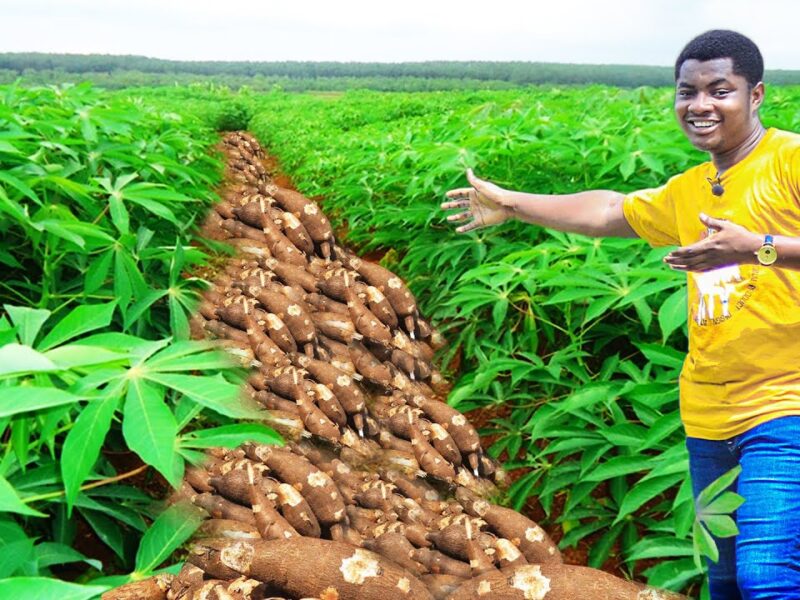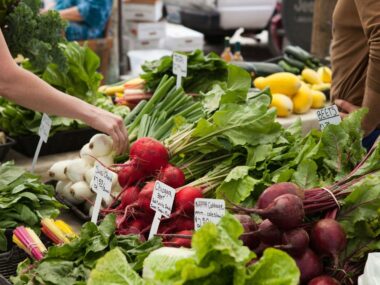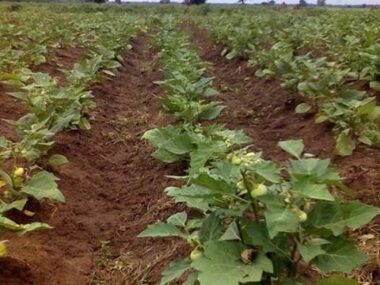Overview of Cassava
Cassava (Manihot esculenta) is a woody shrub native to South America, widely cultivated for its starchy tuberous roots. It is a major food staple in tropical and subtropical regions, particularly in Africa, Asia, and Latin America. Cassava is known for its high carbohydrate content and ability to thrive in poor soils and under drought conditions, making it a critical crop for food security and rural livelihoods.

Benefits of Cassava Cultivation
- Food Security: Cassava is a primary source of calories for millions of people, especially in developing countries.
- Resilience: Tolerates drought and poor soil conditions, ensuring a reliable harvest even in challenging environments.
- Economic Value: Provides income for smallholder farmers through fresh root sales and processed products like flour, tapioca, and ethanol.
- Versatility: Can be processed into various products, including food, animal feed, and industrial starch.
Varieties of Cassava
- Sweet Cassava: Contains lower levels of cyanogenic glycosides and can be consumed after simple boiling.
- Bitter Cassava: Contains higher levels of cyanogenic glycosides and requires thorough processing to remove toxins.
Climate and Soil Requirements
- Climate: Cassava thrives in warm, tropical climates with temperatures between 25°C and 30°C. It can grow in areas with annual rainfall ranging from 500 mm to 2,500 mm.
- Rainfall: Requires well-distributed rainfall during the growing season. It is drought-tolerant but performs best with consistent moisture.
- Soil: Prefers well-drained, sandy loam to loamy soils with a pH of 5.5-6.5. Cassava can grow in nutrient-poor soils but benefits from fertile, well-structured soils.
Stages of Cassava Cultivation
- Land Preparation: Clear the land of weeds and debris. Plow and harrow to create a fine seedbed. Ridging or mounding can improve drainage.
- Planting Material Selection: Use healthy stem cuttings from disease-free, high-yielding plants. Cuttings should be 20-30 cm long with 4-6 nodes.
- Planting Methods:
- Vertical Planting: Insert cuttings vertically into the soil, leaving one node above the surface.
- Slanting Planting: Insert cuttings at a 45-degree angle for better root development.
- Water Management: Ensure consistent moisture, especially during the first three months. Supplement natural rainfall with irrigation if necessary.
- Fertilization: Apply balanced fertilizers based on soil tests. Cassava benefits from organic matter and fertilizers rich in nitrogen, phosphorus, and potassium.
- Weed Control: Weed regularly during the first 3-4 months. Use mulching or cover crops to suppress weed growth and conserve soil moisture.
- Pest and Disease Management: Monitor and manage common pests like cassava mealybugs, mites, and diseases such as cassava mosaic disease and bacterial blight.
- Harvesting: Typically occurs 9-18 months after planting, depending on the variety and growing conditions. Harvest when roots reach the desired size.
- Post-Harvest Processing: Involves peeling, washing, and processing into various products like flour, chips, or starch.
Water Management in Cassava Cultivation
Effective water management is crucial for cassava cultivation:
- Irrigation Systems: Use drip or sprinkler systems to maintain adequate soil moisture, particularly during dry spells.
- Rainfall Harvesting: Collect and store rainwater for supplemental irrigation.
- Drainage Systems: Implement proper drainage to prevent waterlogging, which can lead to root rot and other issues.
Fertilization Practices
Balanced fertilization is key to maximizing cassava yield:
- Nitrogen (N): Essential for vegetative growth. Apply nitrogen fertilizers at planting and during the growing season.
- Phosphorus (P): Important for root development and energy transfer. Apply phosphorus fertilizers based on soil tests.
- Potassium (K): Enhances disease resistance and overall plant health. Apply potassium fertilizers as needed.
- Micronutrients: Ensure adequate levels of micronutrients like zinc, magnesium, and sulfur for optimal growth.
Common Pests and Diseases
- Cassava Mealybugs: Insects that suck sap from the plant, reducing vigor.
- Control: Use insecticides, natural predators like ladybugs, and resistant varieties.
- Cassava Green Mites: Small pests that damage leaves, leading to reduced photosynthesis.
- Control: Use acaricides, resistant varieties, and biological control agents.
- Cassava Mosaic Disease: A viral disease-causing leaf distortion and stunted growth.
- Control: Use disease-free planting material, resistant varieties, and remove infected plants.
- Bacterial Blight: A bacterial disease that causes leaf spots, wilting, and stem rot.
- Control: Use resistant varieties, ensure proper field sanitation, and apply bactericides if necessary.
Harvesting and Post-Harvest Practices
- Timing: Harvest when roots reach the desired size and starch content. Delayed harvesting can lead to fibrous roots and reduced quality.
- Methods: Harvest manually or with mechanical equipment, depending on the scale of cultivation.
- Processing: Peel and wash roots. Process into various products like flour, chips, starch, or ethanol.
- Storage: Store fresh roots in cool, dry conditions to prevent spoilage. Processed products can be stored longer with proper packaging.
Sustainable Cassava Cultivation Practices
- Crop Rotation: Rotate cassava with other crops like legumes or cereals to break pest and disease cycles and improve soil health.
- Cover Crops: Plant cover crops during the off-season to protect and enrich the soil.
- Integrated Pest Management (IPM): Combine biological, cultural, and chemical methods to manage pests sustainably.
- Organic Farming: Avoid synthetic chemicals, using organic fertilizers and natural pest control methods.
Innovations in Cassava Farming
- High-Yielding Varieties (HYVs): Developed to increase productivity and resist diseases.
- Genetically Modified (GM) Cassava: Engineered for traits like pest resistance and improved nutritional content.
- Precision Agriculture: Uses technology like GPS, drones, and satellite imagery for efficient field monitoring and management.
- Conservation Tillage: Reduces soil erosion and conserves moisture by leaving crop residues on the field.
Economic Importance of Cassava
- Global Trade: Major producing countries include Nigeria, Thailand, Indonesia, Brazil, and Congo. Importing countries include China, the USA, and the European Union.
- Employment: Provides livelihoods for millions of farmers and workers in related industries.
- Food Security: Essential for the food security of many developing nations, providing a crucial source of nutrition and income.
Environmental Considerations
- Water Use Efficiency: Implement practices like drip irrigation to conserve water.
- Soil Health: Use crop rotation and organic amendments to maintain soil fertility.
- Climate Change Adaptation: Develop and adopt resilient cassava varieties and farming practices to cope with changing climate conditions.
Challenges in Cassava Cultivation
- Climate Variability: Unpredictable weather patterns can affect water availability and crop health.
- Pest and Disease Pressure: Requires constant monitoring and management.
- Labor Shortages: Mechanization and improved labor practices are needed to address this issue.
- Market Fluctuations: Prices can be volatile, impacting farmer income.
Conclusion
Cassava cultivation during the rainy season presents a unique opportunity to leverage natural water resources for optimal growth. By understanding the requirements, best practices, and challenges associated with cassava farming, farmers can enhance productivity, ensure food security, and contribute to the global cassava supply. Sustainable practices and technological innovations will play a crucial role in meeting the future demands of cassava production while preserving environmental health.










